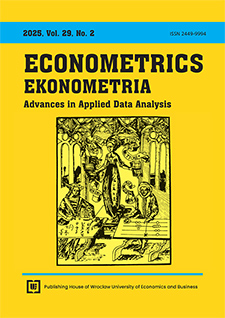Comparative Analysis of Household Debt Levels and Structures in European Countries: Trends and Implications
DOI:
https://doi.org/10.15611/eada.2025.2.02Keywords:
household debt, euro area, financial structure, comparative analysis, consumer creditAbstract
Aim: The aim of the article was to analyse the level and structure of household indebtedness in selected European countries over two periods: 2018–2019 and 2020–2022. The research focused on two key objectives: (1) a comparative analysis of the forms of indebtedness among households in different European countries, and (2) a comparative analysis of the euro area and non-euro area EU Member States with respect to the level and structure of household debt.
Methodology: The study is based on secondary data from Eurostat concerning the financial resources and debt levels of European households. The analysis covered two distinct time periods (2018–2019 and 2020–2022) and compared the prevalence and structure of different debt instruments. The research included descriptive and comparative methods, examining household behaviour in euro area and non-euro area countries.
Results: The analysis showed that there were no statistically significant differences between euro area and non-euro area households in terms of asset and debt categories. In the euro area, households more frequently used short-term and long-term loans, while they were less likely to invest in quoted shares and bonds. In non-euro area countries, short-term loans dominated, suggesting a stronger tendency to use quick access financing tools. Debt securities and long-term loans were less prevalent in these countries.
Implications and recommendations: The findings suggest that household debt preferences were relatively stable across Europe, with minor regional differences. Policymakers should consider these patterns when designing financial literacy programmes and credit regulations. Future research could focus on the behavioural factors influencing household debt decisions and investigate the impact of macroeconomic changes on these trends.
Originality/value: This study contributes to the literature by offering a comparative perspective on household indebtedness in euro area and non-euro area countries, using up-to-date Eurostat data across two relevant time frames. It provides insights into the structure of household liabilities and the regional differences in debt preferences.
Downloads
References
Ando, A. Modigliani, F. (1963), The'life cycle' hypothesis of save: Aggregate implications and tests. The American Economic Review, 53(1), 55–84.
Baker, S. R. (2015). Debt and the consumption response to household income shocks (Vol. 2541142). SSRN.
Barba, A., & Pivetti, M. (2008), Rising household debt: Its causes and macroeconomic implications – a long-period analysis. Cambridge Journal of Economics, 33(1), 113–137.
Barbaglia, L., Manzan, S., & Tosetti, E. (2024). Household debt and economic growth in Europe. Macroeconomic Dynamics, 1-19.
Bertola, G., & Hochguertel, S. (2007). Household debt and credit: Economic issues and data problems. Economic Notes, 36(2), 115-146.
Białowolski, P., Cwynar, A., Cwynar, W., & Węziak‐Białowolska, D. (2020). Consumer debt attitudes: The role of gender, debt knowledge and skills. International Journal of Consumer Studies, 44(3), 191-205.
Blanchett, D. (2015). The value of goals-based financial planning. Journal of financial Planning, 28(6), 42-50.
Bloise, G., & Vailakis, Y. (2024). Sovereign debt crises and low interest rates. Journal of International Economics, 150, 103893.
Byrialsen, M. R.,& Raza, H. (2022). Household debt and macroeconomic stability: An empirical stock‐flow consistent model for the Danish economy. Metroeconomica, 73(1), 144-197.
Canner, G., Kennickell, A., & Luckett, C. (1995). Household Sector Borrowing and the Burden of Debt. Federal Reserve Bulletin, 81, 323-338.
Blackorby, C., Russell, R.R. (1993). Samuelson’s “Shibboleth” Revisited: Proportional Budgeting Among Agents and Rank-Two Demand Systems. In: W. E.Diewert, K. Spremann, F. Stehling (Eds), Mathematical Modelling in Economics (pp. 35-46). Springer, Berlin, Heidelberg.. https://doi.org/10.1007/978-3-642-78508-5_4
Cherry, S. F., Jiang, E. X., Matvos, G., Piskorski, T., & Seru, A. (2021). Government and private household debt relief during COVID-19 (No. w28357). National Bureau of Economic Research. https://doi.org/w10.3386/w28357
Chmelar, A. (2013) Household Debt and the European Crisis. Research Report, 13. European Credit Research Institute.
Christen, M., & Morgan, R. M. (2005). Keeping up with the Joneses: Analyzing the effect of income inequality on consumer borrowing. Quantitative Marketing and Economics, 3, 145-173.
Cloyne, J., Ferreira, C., & Surico, P. (2020). Monetary policy when households have debt: new evidence on the transmission mechanism. The Review of Economic Studies, 87(1), 102-129.
de Almeida, F., Ferreira, M. B., Soro, J. C., & Silva, C. S. (2021). Attitudes toward money and control strategies of financial behavior: A comparison between overindebted and non-overindebted consumers. Frontiers in psychology, 12, 566594.
Dębkowska, K., & Jarocka, M. (2013). The impact of the methods of the data normalization on the result of linear ordering. Acta Universitatis Lodziensis. Folia Oeconomica, 286.
Eurostat. (2021). Household Debt Statistics. Retrieved from Eurostat Database.
Filardo, A. (2009). Household debt, monetary policy and financial stability: still searching for a unifying model. Bank for International Settlements (ed.), Household Debt: Implications for Monetary Policy and Financial Stability, BIS Papers, (46), 31-50.
Flodén, M., Kilström, M., Sigurdsson, J., & Vestman, R. (2021). Household debt and monetary policy: Revealing the cash-flow channel. The Economic Journal, 131(636), 1742-1771.
Foote, C. L., Loewenstein, L., & Willen, P. S. (2021). Cross-sectional patterns of mortgage debt during the housing boom: evidence and implications. The Review of Economic Studies, 88(1), 229-259.
Grace, R. (2024). Becoming Debt-free: A Journey Towards Financial Freedom. A Thousand Words a Day.
Greenberg, A. E., & Mogilner, C. (2021). Consumer debt and satisfaction in life. Journal of Experimental Psychology: Applied, 27(1), 57.
Gritten, A. (2011). New insights into consumer confidence in financial services. International Journal of Bank Marketing, 29(2), 90-106.
Grzywińska-Rapca, M. (2021a). Economic Welfare and Subjective Assessments of Financial Situation of European Households. European Research Studies Journal, Volume XXIV Issue 2, 948-968.https://doi.org/10.35808/ersj/2166
Grzywińska-Rapca, M.(2021b). Finanse gospodarstw domowych w świetle subiektywnych ocen sytuacji materialnej. Uniwersytet Warmińsko-Mazurski w Olsztynie, s.211
Grzywińska-Rapca, M., & Olejarz, A. (2021). The Level of Economic Development and the Savings Rate of Households. European Research Studies Journal, 24(2B), 430-442. https://doi.org/10.35808/ersj/2243.
Grzywińska-Rąpca, M., & Grzybowska- Brzezińska, M. (2023). Financial Situation In The Assessments Of The Head Of The Household And Their Relationship With Debt In Different Phases Of The Life Cycle: A Case Study (Poland). Journal of Eastern Europe Research in Business and Economics, 1–9. https://doi.org/10.5171/2023.426741
Grzywińska-Rąpca, M., & Markowski, L. (2023). Analysing the Financial Landscape of European Households: Insights from Panel Data. Journal of International Studies, 16(3), 34–55. https://doi.org/10.14254/2071-8330.2023/16-3/2
Gumy, J. (2010). Household Debt and Financial Assets in the Process of Economic Development. International Journal of Social Economics, 37(8), 643-661.
Hampson, D. P., Gong, S., Xie, Y. (2021). How consumer confidence affects price conscious behavior: The roles of financial vulnerability and locus of control. Journal of Business Research, 132, 693-704.
Hintermaier, T., Koeniger, W. (2018). Household debt and crises of confidence. Quantitative Economics, 9(3), 1489-1542.
Jappelli, T., Pagano, M. (2002). Information Sharing, Lending and Defaults: Cross-Country Evidence. Journal of Banking & Finance, 26(10), 2017-2045.
Kask, J. (2003). Household debt and financial stability. Kroon and Economy, 4, 35-42.
Keese, M. (2012). Who feels constrained by high debt burdens? Subjective vs. objective measures of household debt. Journal of Economic Psychology, 33(1), 125-141.
Kose, M. A., Nagle, P., Ohnsorge, F., & Sugawara, N. (2021). Global waves of debt: Causes and consequences. World Bank Publications.
Kukuła, K., & Luty, L. (2015). Propozycja procedury wspomagającej wybór metody porządkowania liniowego. Przegląd statystyczny, 62(2), 219-231.
Leclaire, J. (2023). Does household debt matter to financial fragility? Review of Political Economy, 35(2), 434-453.
Łuczak, A., & Wysocki, F. (2013). Zastosowanie mediany przestrzennej Webera i metody TOPSIS w ujęciu pozycyjnym do konstrukcji syntetycznego miernika poziomu życia. Research Papers of the Wroclaw University of Economics, (278).
Martín-Legendre, J. I., & Sánchez-Santos, J. M. (2024). Household debt and financial vulnerability: empirical evidence for Spain, 2002–2020. Empirica, 1-28.
Mehrotra, N. R., & Sergeyev, D. (2021). Debt sustainability in a low interest rate world. Journal of Monetary Economics, 124, S1-S18.
Muthitacharoen, A., Nuntramas, P., & Chotewattanakul, P. (2015). Rising household debt: Implications for economic stability. Thammasat Economic Journal, 33(3), 66-101.
Park, D., Shin, K., & Tian, S. (2022). Household debt, corporate debt, and the real economy: Some empirical evidence. Emerging Markets Finance and Trade, 58(5), 1474-1490.
Perraton, J. (2019). Macroeconomic implications of inequality and household debt: European evidence. In Finance, Growth and Inequality (pp. 93-110). Edward Elgar Publishing.
Samad, K. A., Daud, S. N. M., & Rusmita, S. A. (2022). Household Debt and Economic Growth: The Role of Institutional Quality. Pertanika Journal of Social Sciences & Humanities, 30(3).
Schembri, L. (2024). Connecting the Dots: Elevated Household Debt and the Risk to Financial Stability. Speech before the Guelph Chamber of Commerce/Schembri L.–2016.–24 February.
Turinetti, E., & Hong Z. (2011) Exploring Determinants of U.S. Household Debt. Journal of Applied Business Research (JABR), 27( 6), 85–92, https://doi.org/10.19030/jabr.v27i6.6468
Van Raaij, W. F., & Gianotten, H. J. (1990). Consumer confidence, expenditure, saving, and credit. Journal of Economic Psychology, 11(2), 269-290.
Vanlaer, W., Bielen, S., & Marneffe, W. (2020). Consumer confidence and household saving behaviors: A cross-country empirical analysis. Social Indicators Research, 147, 677-721.
Viale, M., Demo, E., & Ricciuti, R. (2018). Decomposing Economic Inequality in Early Modern Venice (ca. 1650-1800), HHB Working Paper Series, No. 12, October 2018, Rome.
Walesiak, M. (2004). Problemy decyzyjne w procesie klasyfikacji zbioru obiektów. Prace Naukowe Akademii Ekonomicznej we Wrocławiu, Ekonometira, 1010, 52-71.
Xie, Z., Xie, Y., Liu, Y., Xu, G., & Xu, B. (2024). The long‐term impact of household debts on household consumption. Asian Economic Journal, 38(2), 202-231.
Yazdanparast, A., & Alhenawi, Y. (2022). Impact of COVID‐19 pandemic on household financial decisions: A consumer vulnerability perspective. Journal of Consumer Behaviour, 21(4), 806-827.
Zawadzka, A., & Grzywińska‐Rąpca, M. (2023). Financial savings structure—Eurozone and Visegrad Group. International Journal of Finance & Economics, 28(1), 699-717. https:// doi.org/10.1002/ijfe.2445
Zinman, J. (2015). (4) Household Debt: Facts, Puzzles, Theories, and Policies. Annual Review of Economics, 7, 251-276. https://doi.org/10.1146/annurev-economics-080614-115640
Downloads
Published
Issue
Section
Categories
License
Copyright (c) 2025 Małgorzata Grzywińska-Rąpca, Agnieszka Zawadzka

This work is licensed under a Creative Commons Attribution-ShareAlike 4.0 International License.
Accepted 2025-05-08
Published 2025-06-12









